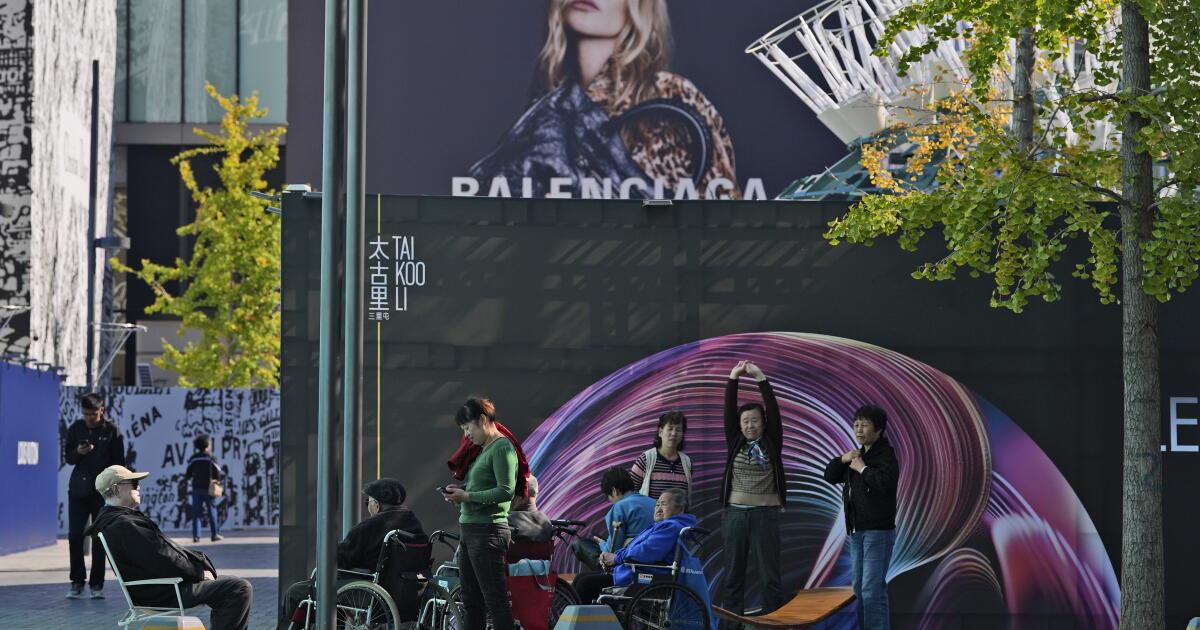Business
$1.80 dinners and budget clothes? The spread of frugality is hurting China's economy

China’s 1.4 billion consumers once spent with enough abandon to help drive the global economy. Now one of the hottest topics on Chinese social media is how to save money.
“The main thing is just not to starve to death,” one video blogger advised in a post detailing how she subsisted on snack samples and free meals from temples and student canteens.
Another has gained a following in reviewing children’s meals that adults in Shanghai can eat on the cheap. “This is so economical,” she marveled over a $1.80 dinner. “They also included fried chicken.”
Other accounts tout $8 gym memberships and the merits of waiting for sales at fast-fashion clothing stores.
The tips appear to be working, as household savings have hit record highs. But experts say that’s bad news for the economy, because widespread scrimping is contributing to a dramatic slowdown in growth this year.
While the bigger factor is a worsening real estate downturn, which has eroded demand for commodities and diminished a crucial vehicle for household wealth and investment, economists say China’s economy is unlikely to recover without a rise in domestic spending.
Real estate agents wait for potential customers outside their Beijing offices in June 2014. China’s real estate downturn has eroded demand for commodities and diminished a crucial vehicle for household wealth and investment.
(Andy Wong / Associated Press)
Hou Muhan, a 28-year-old modeling agent living in Shanghai, used to borrow money from her parents every month to cover her bills.
But this year, after they started asking her to pay them back, she began tracking her expenses and became much stricter about spending at bars or trendy restaurants.
“I noticed every time I exceed my budget it’s usually because I go for drinks,” she said. “Socializing usually costs money. This is something hard to avoid in Shanghai.”

Women sit on a bench in front of a cafe in Shanghai on Oct. 12.
(Andy Wong / Associated Press)
Now she mainly cooks at home. On the rare occasions when she orders in, she divides the rice into three portions, freezing two to eat with other meals at home.
Chinese consumers are going through a “consumption downgrade,” according to an analysis of mobile payment data by Shanghai Pulse Data Technology Co.
At the beginning of last year, a typical Chinese lunch customer spent between $1.40 and $1.70 on a meal. By the end of July, that range dropped to $1 to $1.30 as many diners stopped ordering their noodles with pork in favor of egg or vegetables.

Since her parents began asking her to repay the loans they had been giving her to help with her bills, Hou Muhan of Shanghai became much stricter on her spending and now mainly cooks at home.
(Courtesy of Hou Muhan )
As housing and stock prices have fallen, consumers in 25 out of 32 Chinese cities spent less than average in the first half of the year, according to the report.
Over the last few years, the housing downturn, record youth unemployment and layoffs in tech and other industries have compounded economic pessimism. A highly anticipated rebound in consumer spending after the pandemic never materialized.
Luxury brands are also falling out of favor in China, as shoppers have pulled back on big-ticket purchases. French conglomerate LVMH, an industry bellwether and the owner of the Louis Vuitton and Dior brands, reported a 16% slide in quarterly revenue in Asia excluding Japan last week, as its chief financial officer noted consumer confidence in China had slumped to an all-time low.

Customers attend a Louis Vuitton fashion show in April in Shanghai. The brand’s owner, French conglomerate LVMH, reported a 16% slide in quarterly revenue in Asia excluding Japan last week.
(Andy Wong / Associated Press)
Without faith in their economic futures, consumers are unlikely to let go of the frugality they have adopted in recent years.
“Whenever there is uncertainty about the economy, households save more,” said Alicia Garcia-Herrero, chief economist for Asia Pacific at Natixis, a French investment bank. “Disposable income is not growing. People are losing purchasing power.”
China has relied heavily on infrastructure, manufacturing and exports to drive its economic growth over the last decade. But economists said that as those sectors have matured they have lost some of their power to fuel the economy.
In an interview with the state-run China Daily, Chen Wenling, chief economist for Beijing-based think tank China Center for International Economic Exchanges, said consumption probably would become an engine for faster economic growth in the long run than industrial investment or exports.

Pedestrians pass an electronic screen displaying prices at the Hong Kong Stock Exchange in June 2023.
(Louise Delmotte / Associated Press)
She called on the government to find ways to create more jobs and bolster household income.
It’s unclear what such efforts might entail. Over the last month, officials have announced a raft of incremental measures to lift the economy, including cutting interest rates and financial support for the property and stock markets.
But Ernan Cui, a consumer analyst at Gavekal Dragonomics, wrote in a September report that Chinese leaders are unlikely to roll out actions to directly stimulate consumer spending, such as distributing cash to households.
Cui said that disinclination is partly because high existing household savings would necessitate a cash infusion of hundreds of billions of dollars to have a notable effect. Chinese leaders are also reluctant to exacerbate income inequality or discourage people from looking for work, she said.
Amora Liu said she worked hard to save at least $225 of the $1,000 she earned each month from her job as a legal consultant at a courier company.
“If I spend it all, then I really have no sense of security,” said Liu, 25, who posts video diaries of her budgeting on social media.

Amora Liu left her job in Shanghai this year to move in with her parents in Changsha, China, where her rent and meals are free.
(Courtesy of Amora Liu)
In May, she moved from the city center to the suburbs more than an hour away, cutting her rent in half. She also started cooking for herself every day instead of going to restaurants.
She managed to save up about $4,200 before she took an even more extreme step: quitting her job and moving back in with her parents in Changsha, the capital of Hunan province.
She has used her savings to travel a little, but living at home has cut her consumption and spending dramatically.
Her video blog details a new budget that would make the economists cringe.
Rent? Free.
Lunch and dinner? Free.
Times special correspondent Xin-yun Wu in Taipei contributed to this report.

Business
Paul Oreffice, a Combative Chief of Dow Chemical, Dies at 97

Paul F. Oreffice, who as the pugnacious head of Dow Chemical grew and diversified the company at the same time that he rebuffed Vietnam veterans over Agent Orange, argued that the chemical dioxin was harmless and oversaw the manufacturing of silicone breast implants that were known to leak, died on Dec. 26 at his home in Paradise Valley, Ariz. He was 97.
His family confirmed his death.
Mr. Oreffice (pronounced like orifice) spoke in staccato, fast-paced sentences, and they were often deployed in pushing back against environmentalists, politicians and journalists during an era, the 1970s and ’80s, when the environmental movement was gaining force by focusing on toxic chemicals in the air and water.
Under his 17-year leadership, which included the titles of president, chief executive and chairman, Mr. Oreffice weathered intense controversies.
His public relations instinct was for confrontation, not conciliation. He had an intense dislike for what he perceived as government meddling in business, which he traced to his having grown up in Italy under Mussolini. “I’ve seen what overgoverning can do,” he told The New York Times in 1987. “I was born under a Fascist dictatorship, and my father was jailed by it.”
Mr. Oreffice took the reins of the Dow USA division in 1975, when its public image was tainted from campus protests of the 1960s that had vilified the company as a maker of the incendiary agent napalm, which was widely used in Vietnam.
When Dow pulled out of apartheid South Africa in 1987 under pressure from shareholders, Mr. Oreffice said: “I’m not proud of it. I think we should have stayed and fought.”
In 1977, when Jane Fonda lacerated Dow in a speech at Central Michigan University, not far from Dow headquarters, in Midland, Mich., Mr. Oreffice canceled the company’s donations to the school, writing its president that he could not support Ms. Fonda’s “venom against free enterprise.”
Instead, Mr. Oreffice financed the campaigns of anti-regulation politicians. And he sued the Environmental Protection Agency for surveilling Dow’s sprawling Midland plants from the air when the company refused an on-site inspection.
The case made its way to the United States Supreme Court, which in 1986 ruled against the company, at the time the No. 2 American chemical maker after DuPont. (The companies merged in 2017, then split into three companies.)
In 1983, Rep. James H. Scheuer, Democrat of New York, disclosed that Dow had been allowed to edit an E.P.A. report on the leakage of dioxin, one of the most toxic substances ever manufactured, from the Midland plants into the Tittabawassee and Saginaw Rivers and Saginaw Bay.
E.P.A. regional officials told Congress that their superiors in the Reagan administration ordered the changes to comply with demands made by Dow. Mr. Oreffice, appearing on NBC’s “Today” show, offered a sweeping dismissal.
“There is absolutely no evidence of dioxin doing any damage to humans except for causing something called chloracne,” he said. “It’s a rash.”
His statement brushed aside evidence that dioxin was extremely hazardous to laboratory animals and had been shown in some research to be linked with a rare soft-tissue cancer in humans.
One former Dow president, Herbert Dow Doan, a grandson of the company founder, told a public relations publication, Provoke Media, in 1990 that Mr. Oreffice’s style was not one fine-tuned to mollify critics. “The reason is part ego, part pride,” he said. “Paul is inclined to push his line to the point where some people say he is arrogant.”
There is no question that Mr. Oreffice’s strength of will also uplifted Dow’s businesses, which through the 1970s were overly dependent on basic chemicals like chlorine. When a glut of low-priced petrochemicals flooded the global market in the early 80s, he aggressively reshaped Dow by diversifying into consumer products, such as shampoos and the cleaning fluid Fantastik, and by moving into foreign markets. By 1987, Dow posted a record profit of $1.3 billion (about $3.5 billion in today’s currency).
At the same time, a class-action lawsuit on behalf of 20,000 Vietnam veterans and their families against Dow and other makers of Agent Orange was further tarnishing the company’s image. The suit, filed in 1979, charged that dioxin in Agent Orange led to cancer in combat veterans and genetic defects in their children.
Dow argued that it had made Agent Orange at the request of the government and was not responsible for how it was used. But in 1984, the company and other makers of Agent Orange, without admitting liability, settled the lawsuit for $180 million, with the proceeds going to veterans and their families.
In another controversy, Dow Corning, a joint venture between Dow Chemical and Corning Inc., released documents in February 1992 showing that it had known since 1971 that silicone gel could leak from breast implants it made.
Tens of thousands of women had sued the company, claiming their implants had given them breast cancer and autoimmune diseases. Dow Corning agreed to a $3.2 billion settlement after the company had been driven to file for bankruptcy protection.
In 1999, an independent review by an arm of the National Academy of Sciences concluded that silicone implants do not cause major diseases.
Paul Fausto Orrefice was born Nov. 29, 1927, in Venice. His parents, Max and Elena (Friedenberg) Oreffice, moved the family to Ecuador in 1940 as Mussolini declared war on Britain and France. Paul came to the U.S. in 1945, entering Purdue University with fewer than 50 words of English at his command.
He graduated with a B.S. in chemical engineering in 1949, became a naturalized citizen, and after two years in the Army went to work for Dow in 1953.
“When I walked into Midland, Mich., this was ‘WASP’ country, and I was a ‘W’ but I wasn’t an ‘ASP,’” he told The Washington Post in 1986. “I spoke with an accent and combed my hair straight back, which just wasn’t done.”
Mr. Oreffice represented Dow in Switzerland, Italy, Brazil and Spain before being called back to the Midland headquarters in 1969 and appointed the company’s financial vice president. He became president of Dow Chemical U.S.A. in 1975 and was then promoted to president and chief executive of the parent Dow Chemical Company in 1978. In 1986, he added the title of chairman.
To the astonishment of many observers, Dow poured millions of dollars in the mid-1980s into a public-relations campaign to improve its image, including a new slogan, “Dow let’s you do great things.”
Under company rules, when he reached age 60, Mr. Oreffice stepped down as president and chief executive in 1987. He retired as chairman in 1992.
He is survived by his wife of 29 years, Jo Ann Pepper Oreffice, his children Laura Jennison and Andy Oreffice, six grandchildren and one great-granddaughter.
In retirement, Mr. Oreffice pursued a passion for thoroughbred racehorses, investing in Kentucky Derby starters and spending summers at a home in Saratoga Springs, N.Y. He was a partner in a Preakness Stakes winner, Summer Squall, and a Belmont Stakes winner, Palace Malice.
In 2006, he published a memoir about rising from an immigrant with little English to a corporate titan, titling it “Only in America.”
Business
As the worst disaster raged around them, hired hands kept working to pay the bills

As an enormous plume of dark gray smoke rose hundreds of feet from the nearby Palisades fire on Wednesday afternoon, obscuring the sun and turning everything in the north end of Santa Monica an apocalyptic shade of orange, a small army of hired hands went about their business as if it were just another day on the job.
Amid the tension and anxiety in this normally cozy seaside enclave — Santa Monica looks and feels like an extremely prosperous Midwestern suburb plunked on a cliff overlooking the Pacific Ocean — landscapers kept trimming, builders kept building, and delivery trucks steered around electric cars packed with fleeing residents.
The weather was “fine for trimming trees,” said Adrian Rodriguez, as he tossed a coiled garden hose into the back of an ancient Nissan pickup. “The sparks aren’t falling yet.”
It was 3 p.m., and Rodriguez, who lives in Los Angeles but is originally from Querétaro, Mexico, had already put in an eight-hour day as one of the worst natural disasters in California history raged around him.
Most of his labor was a little farther from the fire line, he stressed.
And that’s how it goes this awful week in west Los Angeles, normally a dreamscape of gorgeous beaches and breathtaking sunsets. Those who seem to have everything you could possibly ask for are justifiably terrified of losing it. Those who don’t must keep working to get by.
A couple of blocks closer to the ocean, on Palisades Avenue, David Salais and an entirely Spanish-speaking crew of construction workers reluctantly pulled their tools from a $13-million (according to Zillow) home. They were loading the stuff into their trucks as a Santa Monica Police Department cruiser rolled by, repeating a mandatory evacuation order from the loudspeaker.
“We work wind, rain, fire, natural disaster. We don’t stop. We just keep on going until the cops kick us out,” Salais said, leaning on his 6-foot-long carpenter’s level and nodding in the direction of the police car.
Salais, from Santa Paula, said he was born in the U.S. and is “half Mexican.” He was the only person in the stream of workers sauntering out of the house who was willing to be interviewed in English, mostly.
Mexicans are wired differently, he joked, gesturing to the guys around him. “Tienen ganas pa trabajar — they really want to work!”
A few blocks south, as residents struggled to shuttle precious keepsakes from their elegant homes — financial documents, irreplaceable family photos, an enormous stand-up double bass — to cars waiting in the street, Marvin Altamirano steered his UPS delivery truck between them.
With a sun visor on backward and a pen stuck in the elastic band, he patiently removed one of his earbuds to better hear a reporter ask why he was still making deliveries.
“We gotta pay bills,” he said. “It’s not like they’re gonna pay us to stop working and leave.”
He had been making deliveries in Pacific Palisades on Tuesday, during the worst of the fire, but hadn’t gotten too close, he said. The smell of smoke was worse in Santa Monica at 3 p.m. Wednesday, he said.
Would he make a delivery if the street were on fire?
“Depends,” he said, with a laugh. “Like, how close is it, really? If it was down the street, yeah, I’d drop it and go.”
Just before the evacuation order reached their worksite, on Marguerita Avenue near Ocean Avenue, a construction crew calmly repaired a damaged balcony at an apartment building, the team’s ladder lashed to the structure to help brace it in the howling wind.
“We have to survive; that’s why we’re still here,” said Josue Curiel, who lives in Inglewood and is originally from Jalisco, Mexico. Everyone on his crew of about half a dozen were also born south of the border.
“If you’re a worker, you’re hungry, so that’s what it is.”
Business
As Art Sales Fall, Christie’s and Sotheby’s Pivot to Luxury

When art works fetch spectacular auction prices, like the record $450.3 million for Leonardo da Vinci’s “Salvator Mundi” in 2017, the world’s focus turns for a moment to the arcane goings-on of the international art trade. But with the market in a downturn for the last two years, there have been few attention-grabbing sales at the world’s two biggest and oldest auction houses, Sotheby’s and Christie’s.
An exception came at November’s marquee auctions of modern and contemporary art in New York, when the world’s media — and social media in particular — were momentarily enthralled by the seeming absurdity of a cryptocurrency investor spending $6.2 million at Sotheby’s for a duct-taped banana. But there is a big difference between $6.2 million and $450.3 million.
Sales at Sotheby’s and Christie’s were down for the second year in a row in 2024, according to preliminary figures released by the companies in December. With both supply and demand for big-ticket art in a slump, the auction houses are making major bets on selling luxury goods and niche experiences to make up the shortfall.
Sotheby’s estimated it would have turned over about $6 billion in auction and private sales by year-end, a decline of 24 percent on 2023. Christie’s announced projected aggregate sales of $5.7 billion, down 6 percent year-on-year. Back in 2022, Sotheby’s and Christie’s posted annual turnover of $8 billion and $8.4 billion.
“The auction houses have major problems,” said Christine Bourron, the chief executive of the London-based company Pi-eX, which analyzes art sale results. “They really need to do some thinking about how they can bring some life into their auction business. People who have an interest in art want to have an experience,” added Bourron, who, like many followers of the auction market, finds both Sotheby’s and Christie’s live and online sales increasingly predictable.
Sotheby’s is owned by the French-Israeli telecoms magnate Patrick Drahi, whose beleaguered Altice group is burdened with $60 billion of debt. Sotheby’s deteriorating performance led the auction house to reach out to Abu Dhabi’s sovereign wealth fund, A.D.Q., for a $1 billion cash-for-equity bailout and to lay off more than 100 employees in December. This followed some costly infrastructure decisions: Sotheby’s $100-million purchase of the Breuer Building in New York’s Madison Avenue, the opening of a new headquarters in Paris and the development of a futuristic exhibition and retail space in Hong Kong.
Sotheby’s website now abounds with opportunities to buy pre-owned luxury items at auction or by “instant purchase,” as if in a store, ranging from real estate, classic cars and dinosaur fossils, to smaller prestige collectibles like designer handbags, jewelry, fine wines and game-worn N.B.A. jerseys.
Josh Pullan, Sotheby’s global head of luxury, said sales of such goods draw in wealthy clients who may, in time, start to buy high-end art. “Luxury categories are for us a vital gateway for new, often younger, collectors,” he added.
Last year, luxury generated about 33 percent of sales at Sotheby’s, compared with 16 percent at Christie’s, according to the companies’ communications teams. But the category attracted more buyers than art did.
Guillaume Cerutti, the chief executive of Christie’s, spoke to reporters last month during an end-of-year media call. “Luxury has an advantage, because of the model and the price points,” he said. “Luxury and art will merge with each other,” he added, hinting at future synergies of presentation and categorization.
Christie’s is owned by the luxury goods billionaire François-Henri Pinault, whose Kering conglomerate has also been hit by flagging sales. After introducing handbag auctions back in 2014, Christie’s is now having to catch up with Sotheby’s offering of luxury items and trophy collectibles, like dinosaur skeletons. In September, Christie’s announced that it had reached an agreement to acquire the California-based classic car auctioneers Gooding & Co., setting up a rivalry with Sotheby’s car business, RM Sotheby’s, which last year turned over $887 million in classic auto sales.
“The luxury resale market presents a compelling opportunity for auction houses,” said Daniel Langer, a professor of luxury strategy at Pepperdine University in Malibu, Calif. “Storytelling is a critical success factor in the luxury industry. Auction houses excel in this area — take the recent banana auction as an example,” he added. Sotheby’s marketing, like that of a luxury brand, had skilfully woven a narrative around the sensation that the banana sculpture, by the Italian artist Maurizio Cattelan, created when first exhibited at the Art Basel Miami Beach fair in 2019.
However, this opportunity comes with “significant challenges,” according to Langer. He pointed out that unlike luxury brands, auction houses don’t produce and price all of their own inventory; profit margins on new luxury items are often much higher than their resold equivalents; and unlike conglomerates such as LVMH and Kering, auction houses can’t scale their transactions through a network of retail outlets. These disparities between retail and resale “could limit the overall financial impact of luxury for auction houses,” he said.
Changing spending patterns among the wealthy could also affect demand.
Global sales of luxury flatlined in 2024 for the first time since 2008 (excluding 2020, during the coronavirus pandemic), according to a recent report by the management consultants Bain & Co. The report’s authors said consumers were prioritizing “experiences over products” in these uncertain times and that the luxury goods market, rather like the art market, is suffering from buyer fatigue.
“The super-wealthy in their 30s, 40s and 50s are spending their money on luxury experiences,” said Doug Woodham, a former Christie’s executive who now advises on art-related finance. “That’s money that isn’t being spent on a Matisse drawing,” he added.
“With superluxury experiences, the social cache is so much higher,” said Woodham, who pioneered handbag sales at Christie’s in 2014. “For half a million dollars I can have my 10 best friends on a lavish yacht. They will remember that more than sitting in my house with a Rothko on the wall.”
The global luxury yacht charter market grew to an all-time high of $16.3 billion in 2024, a 6 percent increase on the previous year, according to the Business Research Company. It said that growth has been driven by the popularity of “exclusive and exotic travel destinations” and the “ongoing trend towards experiential luxury.”
In September, Sotheby’s collaborated with the Marriott International hotel chain and the fashion house Alexander McQueen to offer a sealed bid auction, in which bidders can’t see the rival offers. The winner got a two-night stay one of the group’s 5-star London sites as part of an experience that the Sotheby’s website said would “transport guests to where a teenaged McQueen first learned the art of tailoring.” Also included were a five-course fine-dining meal for two, a bespoke tour of London with a private visit to the Victoria & Albert Museum and a personalized photo session with Ann Ray, a longtime McQueen collaborator. Classifying the auction as a private sale, Sotheby’s declined to reveal how much the winning bidder paid for this unique luxury experience, but the presale estimate was $12,000 to $18,000.
Could selling memories, instead of art, be the future of the auction business?
-

 Business1 week ago
Business1 week agoThese are the top 7 issues facing the struggling restaurant industry in 2025
-

 Culture1 week ago
Culture1 week agoThe 25 worst losses in college football history, including Baylor’s 2024 entry at Colorado
-

 Sports1 week ago
Sports1 week agoThe top out-of-contract players available as free transfers: Kimmich, De Bruyne, Van Dijk…
-

 Politics1 week ago
Politics1 week agoNew Orleans attacker had 'remote detonator' for explosives in French Quarter, Biden says
-

 Politics7 days ago
Politics7 days agoCarter's judicial picks reshaped the federal bench across the country
-

 Politics5 days ago
Politics5 days agoWho Are the Recipients of the Presidential Medal of Freedom?
-

 Health4 days ago
Health4 days agoOzempic ‘microdosing’ is the new weight-loss trend: Should you try it?
-

 World1 week ago
World1 week agoIvory Coast says French troops to leave country after decades


















